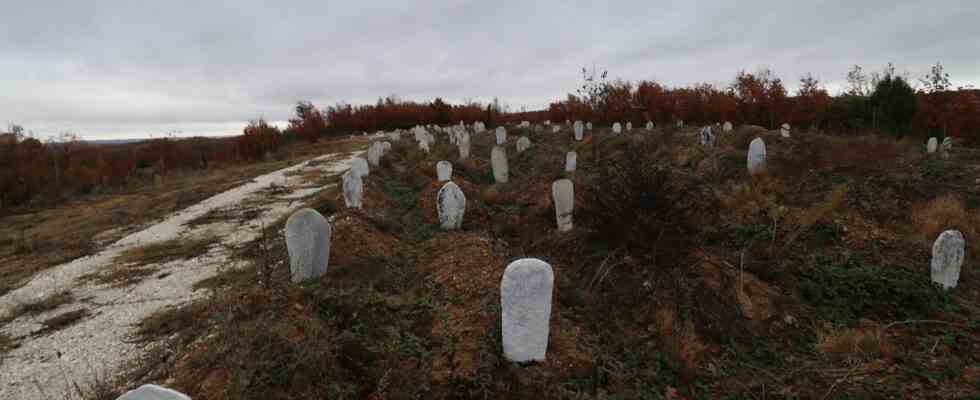Status: 08.02.2023 4:08 p.m
Attempts to enter the EU on the Greek-Turkish border river Evros repeatedly end in death. The deceased are often found late and remain nameless – a trauma for the relatives.
On October 17, 2022, 22-year-old Suhur crossed the Evros, the border river between Turkey and Greece. A smuggler promises the woman from Somalia that he will take her to Thessaloniki. Arriving on the Greek side, we quickly continue through a forest.
But Suhur has severe stomach pains, after a few kilometers she can no longer walk. The others in the group leave her alone, her friend promises to seek help. But it doesn’t come to that. Days later, the police find her body.
It is Suhur’s uncle Fahti who tells her story after identifying her body at the University Hospital in Alexandroupoli.
Tight controls along the shore
Suhur is one of many people trying to cross the Evros to reach Europe. The river marks an external border of the European Union. However, there are close controls along the Greek shore, and different police units are regularly on the move in the area.
Access to the border zone itself is strictly forbidden, and you can only go near the river with a special permit. A border fence has been erected since 2020, it is already 38 kilometers long, and it is intended to prevent migrants from crossing illegally.
The border fence is already 38 kilometers long and is to be extended.
Image: Rüdiger Kronthaler
Still sad records
But apparently the measures are not having the desired effect. According to the UNHCR, 6,022 refugees reached Greece by land in 2022 alone, which is similar to the number before the controls were tightened.
A sad record is set by the number of dead that are found. According to official figures, at least 63 people died trying to escape, but the actual numbers are likely to be significantly higher.
A coroner counts the dead
In Alexandroupoli, on the Greek side, Pavlos Pavlidis works as the region’s forensic pathologist. Every dead refugee found on the Evros is autopsied by him.
Pavlidis keeps a record of the number of dead on the Evros. The dead body of the Somali woman Suhur was also brought to him from a forest near the river.
Forensic doctor Pavlidis is currently talking about 52 unsolved cases, behind each of which there will be relatives who miss these people. Losing your identity is like a second death, says the coroner.
Image: Rüdiger Kronthaler
Traveled from London to identify niece
Now her uncle Fahti is sitting on a sofa in his office. She was a beautiful woman, he says. Fathi has traveled from London to identify his niece.
Fathi says that Suhur’s girlfriend turned himself in to the Greek police to take her to Suhur, who was seriously ill. But the police didn’t look for her and the girlfriend was immediately deported back to Turkey.
This version of events can no longer be verified. The “push-back” practice, the deportation of migrants without due process, has never been officially confirmed by the Greek government. Nevertheless, there are many similar reports from those affected.
Forensic pathologist Pavlidis autopsied Suhur’s dead body and came to the conclusion that the young woman suffered a perforated stomach while fleeing, probably caused by great stress. In the end she died of sepsis. Diseases caused by exhaustion are a common cause of death on the Evros, but the most common is drowning in the river.
Many refugees can hardly swim
Pavlidis says that the tugboats, who overloaded the inflatable boats so much that they quickly capsized, were initially responsible for the many deaths. Many refugees can hardly swim, so the river becomes a danger to their lives.
The refugees themselves apparently underestimated the danger of the crossing. But the strict shielding of the border also means a danger for them. In order to avoid the border guards, they take increasingly dangerous routes.
Anyone who is caught must be afraid of being deported. If one of the group is injured, they must expect to be left alone. Because getting help would mean for everyone that their expensively paid escape would be stopped for the time being.
Currently 52 unexplained deaths
Again and again the police find dead people in the wooded mountains along the river. After just a few days, the corpses can hardly be identified. Pavlidis tries anyway, looking for the cause and time of death and for answers to the question of who this person was.
Pavlidis is currently telling of 52 unsolved cases. Behind each individual are relatives who miss these people. Losing your identity is like a second death, says the coroner.
They made it across the Evros – now the refugees are trying to hide from the border police in a forest near Pythio.
Image: picture alliance/dpa
Around 200 tombstones commemorate the nameless dead
In order to give the nameless dead a final resting place, a cemetery dedicated to them was built in the mountains near the municipality of Sidiro. About 200 tombstones stand here on a slight hill. There are numbers on the plates. Pavlidis keeps a list of relevant numbers in his office.
If at some point a relative came to him and identified a dead person with the help of a DNA sample, he could be dug up and reburied in the cemetery of the nameless.
In the case of the Somali woman Suhur, Pavlidis succeeded in identifying her. For weeks her uncle Fathi lived with the uncertainty of what might have happened to his niece.
After filing a wanted report with the Greek police, he now lives with the brutal knowledge that Suhur has died. At least he now has clarity, he says, so that he and his family can say goodbye to Suhur.
You can also see a report on this topic in the daily topics – today at 10.30 p.m. in the first.

